South Korea
Military launches by nation, 2023


During the first half of 2024, China and the United States each launched five military missions to orbit. The Ukraine war, in its third year, continued to demonstrate the utility of satellites for intelligence, targeting and communication.
INSIGHT: Rising space nations: 5 high-potential markets to watch
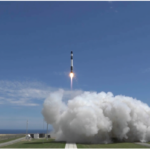
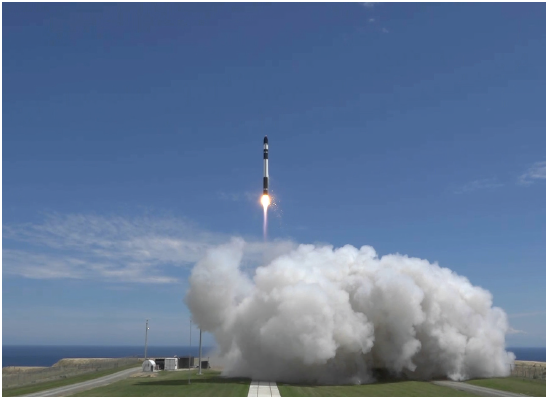
Justin Annibali is chief executive officer and co-founder of Global Space Exchange, a Washington, D.C.-based company that provides market information and analysis of space capabilities and technologies. In this article, Annibali examines key factors for nations planning success in the global space economy.
Government space budgets grow 11% to reach new heights


International government space budgets reached new heights in 2023 with $125 billion spent on space programs, 11% higher than a revised 2022 total of $113 billion.
Rocket Lab launches NASA solar sail test, South Korean observation satellite


Rocket Lab launched two satellites on April 24. One is an Earth observation satellites for a Korea university and the other is a solar sail technology demonstration.
Launch Attempts by Country and Category, 2023
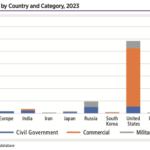
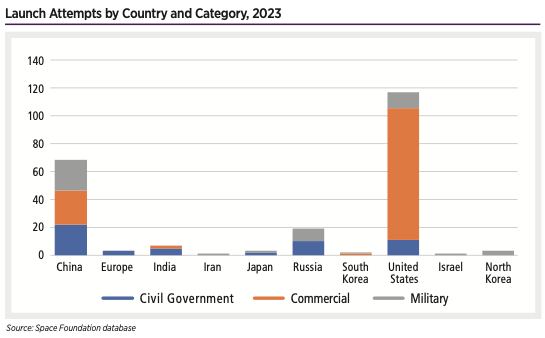
The United States launched 11 military missions in the year, including payloads for the National Reconnaissance Office and a new generation of small communications satellites for the Space Development Agency. Russia launched 10 civil government missions in 2023, including Soyuz launches to send crews to the International Space Station, which remains one area of cooperation between the Kremlin and NASA. India made headlines with its successful launch of a lunar probe while the European Space Agency, awaiting its new Ariane-6 launch vehicle, launched three spacecraft including its Euclid space observatory.
Active Launch Vehicle Operators by Type, 2000-2022


Orbital launch attempts have more than tripled since a lull in activity in the early 2000s bottomed out at 55 attempts in 2004. Part of the rapid growth in the past few years is due to a sharp increase in launch vehicle operators after a long period with an average just shy of 10 distinct operators per year.
Science and Engineering Degrees, in Thousands, 2000-2016


“Space education, research, and workforce development in the public and private sectors are core components of the U.S. national interest, with the potential to drive exploration and scientific discovery, to find new solutions for pressing challenges, including climate change, to strengthen American national security, and to provide good-paying jobs for Americans,” the roadmap document states.
South Korean Space Budget, 2005-2021
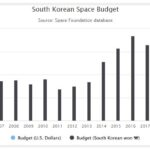

The South Korean government continued development of a Korean-made launch vehicle and improvement in the country’s ability to utilize information gathered by satellites.
Launch Attempts by Country and Mission Type, 2022
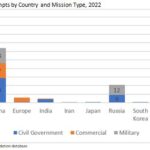
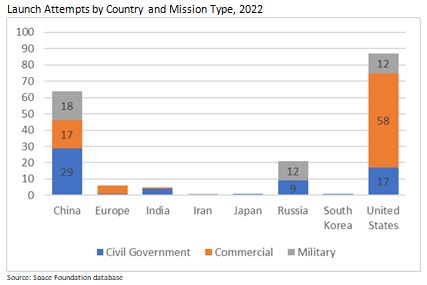
While the U.S. typically leads commercial satellite launches, China almost doubled its private missions in 2022—commercial payloads were 27% of the nation’s launches compared to 16% in 2021. Chang Guang Satellite Technology Co. launched five batches of high-resolution imagery satellites for its Jilin-1 constellation and has deployed approximately half of its planned 138 satellites.
SNAPSHOT: Lunar Missions

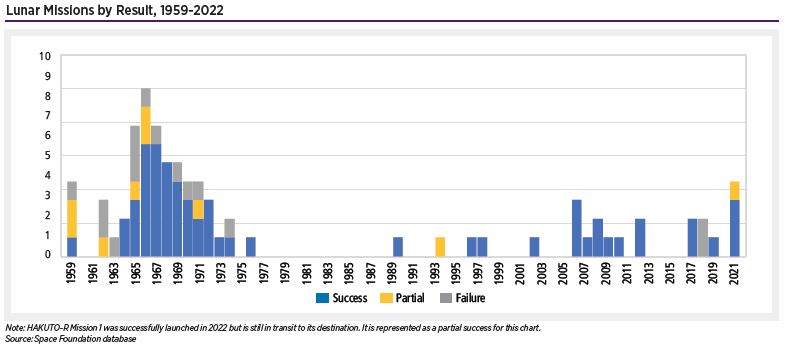
The first attempted lunar mission was the Soviet Union’s Luna 1 impactor, which launched Jan. 2, 1959, and passed within only 5,995 kilometers of the Moon at its closest point. The Space Race brought a large wave of lunar activity in the 1960s, but there have only been a few missions in the decades since.